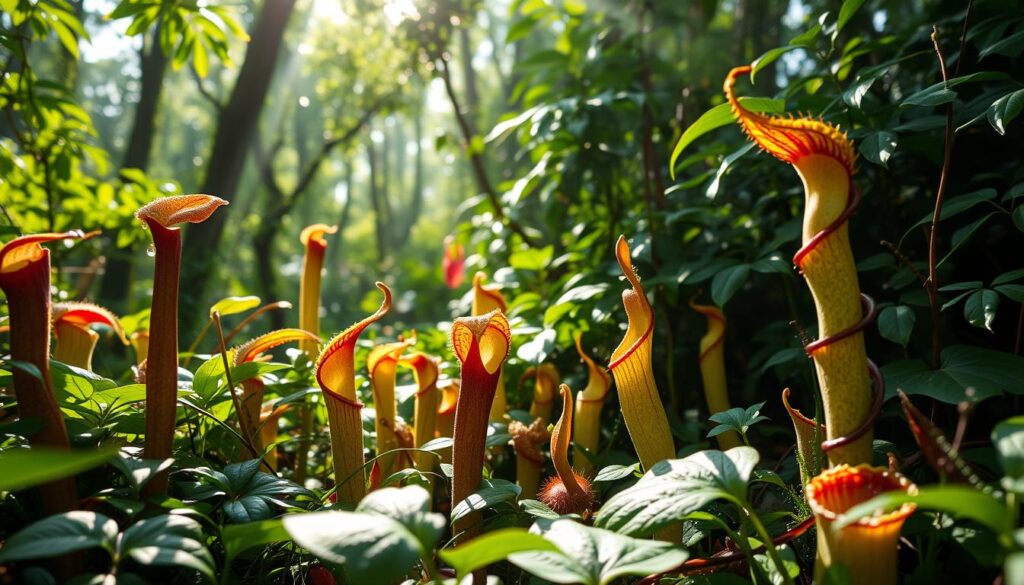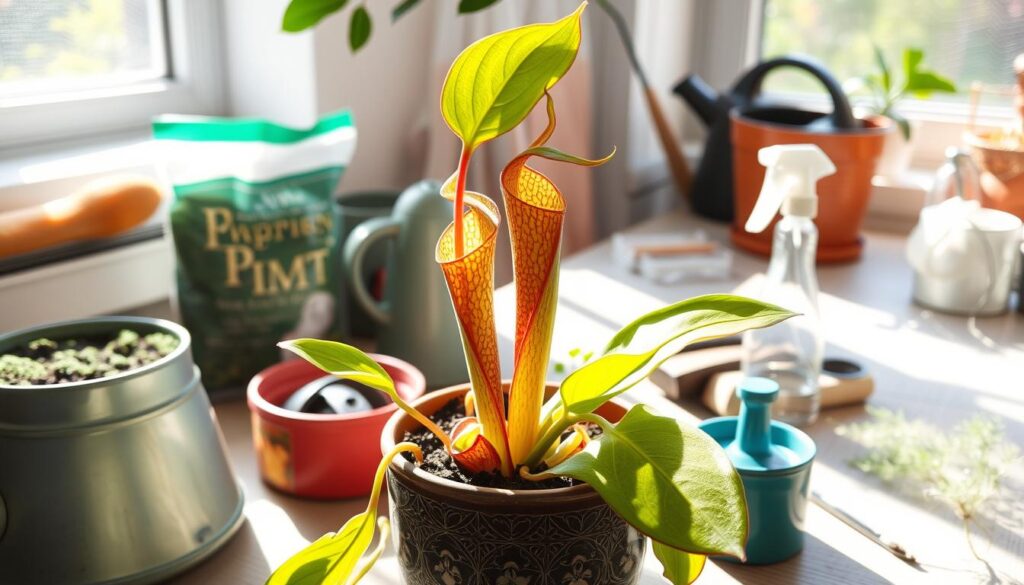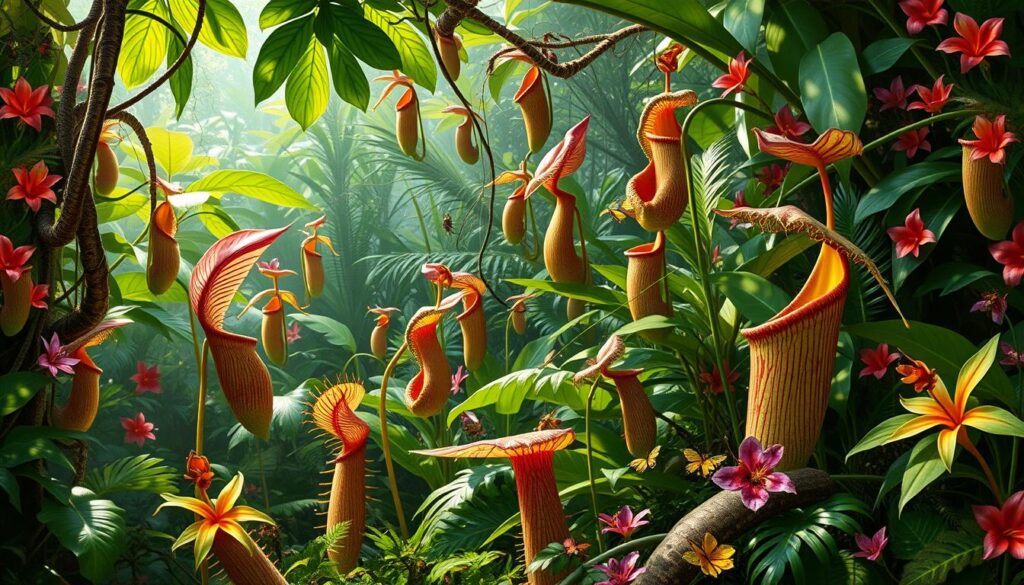Pitcher plants, a type of carnivorous plants, have long fascinated many. People often wonder if they are poisonous and if they can harm humans or pets. Research on tropical pitcher plants shows they are not toxic to humans. They are safe to handle and can even help the environment as a unique garden addition.
Pitcher plants are not poisonous but carnivorous. They get nutrients by catching and digesting insects. With the right care, they can grow well in many places. This makes them a great choice for those who love plants and want to learn more about them.
Pitcher plants, like Nepenthes and Sarracenia, are often misunderstood. Learning about them helps clear up myths about their toxicity and care. For more info on pitcher plants and how to care for them, check out housegardenia.
Table of Contents
Understanding Pitcher Plants
Pitcher plants are big carnivorous plants that catch and digest insects for nutrients. They have unique leaves that form a deep, slippery cup. This cup traps insects.
There are many types of pitcher plants. They belong to families like Nepenthaceae, Cephalotaceae, and Sarraceniaceae. Each family has different pitcher shapes and sizes. They also attract different insects.
What Are Pitcher Plants?
Pitcher plants are carnivorous plants that grow in poor soil. They get nutrients by eating insects. This helps them survive in places where other plants can’t.
Types of Pitcher Plants
Some common pitcher plants include:
- Nepenthes, with over 100 tropical species
- Sarracenia, with about 10 species from eastern North America
- Cephalotus, with just one species in southwestern Australia
Habitat and Growth Conditions
Pitcher plants live in bogs, swamps, and rocky areas. They need full sun to partial shade. They also prefer acidic soils with a pH between 3.0 and 5.0. With the right care, they can be a fascinating addition to any garden.
The Predatory Nature of Pitcher Plants
Pitcher plants are carnivorous plants that catch and digest insects and small organisms. They attract prey with nectar and have slippery leaves. This helps them get nutrients they need.
Insects are drawn to the plant’s nectar. Once they land, they fall into the pitcher and get trapped. The plant’s digestive fluids then break them down. This gives the plant nutrients like nitrogen and phosphorus.
The Nepenthes attenboroughii can grow up to 1.5 meters tall. Its pitchers are 30 centimeters wide. These plants live in bogs, swamps, and rocky areas around the world.
To care for these plants, they need high humidity and full sun to partial shade. They also need a diet of live insects. This is key for their health.
Knowing how pitcher plants work is important for their care. By giving them the right conditions and nutrients, they can thrive. Learning about carnivorous plants is rewarding and interesting for gardeners of all levels.
Are Pitcher Plants Poisonous to Humans?
Pitcher plants are often thought to be poisonous plants, but research shows they are not toxic to humans. If you accidentally ingest a pitcher plant, call the American Association of Poison Control Centers at 1-800-222-1222. Even though they are not poisonous plants, it’s wise to be careful, mainly around kids and pets.
About 88% of parents worry about the dangers of houseplants. To lower risks, setting up barriers or child-free zones can cut down accidents by up to 70%. Teaching kids about plant toxicity and why they shouldn’t eat plants can also help.
If someone eats a plant, rinse their mouth and spit out any plant parts. If they start swelling or have trouble breathing, call for emergency help right away. While pitcher plants are safe, knowing the risks and taking steps to keep everyone safe is key.
- Keep plants out of reach of children and pets
- Create barriers or child-free zones around plants
- Educate children about plant toxicity and the importance of not ingesting plants
- Seek emergency medical help if symptoms of an allergic reaction arise
The Toxin Debate
The talk about plant toxins in pitcher plants is complex. Many things need to be thought about. These plants make toxins, but the danger is usually small. The Pitcher Plant is seen as safe by poison control centers. It’s different from many carnivorous plants that can be harmful to people.
Some important things to remember about the toxins in pitcher plants are:
- Too much contact with Pitcher Plants can cause mild skin problems like redness or itching.
- Eating parts of Pitcher Plants might upset your stomach or make you feel sick.
- Children and older people should be careful around these plants. They might be more affected by them.
Pitcher plants aren’t the only ones with toxins. Many carnivorous plants have similar chemicals. These help them catch and eat prey. Knowing about plant toxins helps us understand these plants better.

| Plant Species | Toxin Production | Risks to Humans |
|---|---|---|
| Pitcher Plant | Mild toxins | Mild skin irritation, digestive discomfort |
| Venus Flytrap | More potent toxins | Potential for more severe skin irritation, digestive issues |
| Sundew | Mild toxins | Mild skin irritation, digestive discomfort |
Benefits of Pitcher Plants
Pitcher plants are not just beautiful; they’re also good for the environment. They bring a unique look to gardens, drawing eyes with their interesting shape and vibrant colors.
The ecological importance of pitcher plants is huge. They help support biodiversity by being homes for insects and tiny creatures. They also do well in tough spots where other plants struggle, making them great for eco-friendly gardens.
- Low maintenance requirements
- Unique and attractive appearance
- Contribution to biodiversity
- Ability to thrive in challenging environments
Pitcher plants are a smart pick for gardeners. They add a special touch to gardens while helping the environment. They’re perfect for those who want a unique and sustainable space.
Caring for Pitcher Plants
Pitcher plant care is all about mimicking their natural habitat. This means keeping the air humid and the light indirect. For example, placing the plant near a south-facing window helps it grow well.
It’s also important to water them regularly. Pitcher plants need about 0.5 cups of water every 7 days. Make sure the soil mix holds moisture but also drains well. It should include organic matter like coco coir or sphagnum moss.
Some key tips for caring for pitcher plants include:
- Repotting the plant after it doubles in size or at least once a year
- Using a good potting soil mix that retains moisture and drains well
- Providing high humidity and indirect sunlight
By following these tips, you can keep your pitcher plants healthy. This way, you’ll enjoy the special benefits these plants offer.

For more tips on caring for carnivorous plants, talk to a gardening expert. Or check out a reliable online resource.
| Pitcher Plant Species | Optimal Growing Conditions |
|---|---|
| Sarracenia purpurea | High humidity, indirect sunlight, and regular watering |
| Sarracenia flava | Similar to Sarracenia purpurea, with a focus on well-draining soil |
Myths and Misconceptions
Many myths about pitcher plants have caused confusion. One myth is that they are toxic to humans and animals. But, this is not true. These plants capture and digest insects to get nutrients, not because they are toxic.
Some people don’t understand pitcher plants well. They think these plants are toxic because they live in poor soil. But, this is actually a clever way they get nutrients.
To clear up these myths, let’s look at the facts about pitcher plants. Here are a few important points:
- Pitcher plants are not toxic to humans or animals.
- They capture and digest insects to get nutrients.
- These plants are key to their ecosystems, helping keep nature balanced.
By understanding these myths, we can see how special pitcher plants are. We can also work to make sure more people appreciate these amazing plants.
Pitcher Plants in Popular Culture
Pitcher plants have always been fascinating, thanks to their unique look and horticultural interest. They’ve caught the eye of many in media, like books and movies. They often stand for something exotic and mysterious. For example, pitcher plants in culture are seen as having special powers in stories.
Artists and writers love their unusual traits, making them a big part of popular culture. Some tales tell of pitcher plants that eat people, showing a deep interest in these plants. But in truth, they’re safe for humans. Their ability to eat insects and small animals has made them interesting to study and use.

Studies show over 600 plant types eat insects and small creatures. Pitcher plants are special because they can catch prey underground. This has made them a focus for scientists, showing their horticultural interest.
As we learn more about pitcher plants, their horticultural interest will likely grow. This will lead to more efforts to protect them. By looking into pitcher plants in culture, we can appreciate their role in our world and the need to save their homes.
Conservation Efforts
Pitcher plant conservation is key to protect these unique plants and their homes. Habitat preservation is vital to keep ecosystems balanced where pitcher plants live. Threats include habitat loss, climate change, and over-harvesting.
Mohd Fauzi Abu Bakar has collected 50 Nepenthes species over 23 years. This is one-third of all known Nepenthes species. Malesiana Tropicals has also grown about 150 Nepenthes varieties, including new species and hybrids.
The need for habitat preservation is huge for pitcher plant survival. Conservationists have collected over 17,000 seeds from Southern Appalachian purple pitcher plants. Kew horticulturists and the Carnivorous Plant Society have moved and rehomed purple pitcher plants. This shows how conservation works.
To help pitcher plant conservation, we must support sustainable gardening and protect natural habitats. Together, we can save these amazing plants and their homes.
| Pitcher Plant Species | Conservation Status |
|---|---|
| Nepenthes rajah | Appendix I of CITES |
| Purple Pitcher Plant | Appendix II of CITES |
Pitcher Plants as Safe Companions
Pitcher plants are fascinating and safe to have around. They might seem scary because they eat insects, but they’re not harmful to people or pets. When grown right, they can add beauty to any space.
Summary of Key Points
Pitcher plants catch and eat small insects to get nutrients. But, their toxins aren’t strong enough to hurt bigger animals, like kids or pets. With the right care, these plants are safe and can even thrive.
Encouragement to Cultivate Awareness and Interest
Learning about pitcher plants is exciting and helps protect them. As we learn more about these plants, it’s important to grow them responsibly. We invite you to discover pitcher plants and add them to your garden. They’re safe and beautiful companions.
Frequently Asked Question
Is a pitcher plant harmful to humans?
No, pitcher plants are not harmful to humans. They’re carnivorous, but they primarily trap and digest insects. Their digestive fluids won’t hurt your skin, so you’re safe around these plants as long as you don’t try to ingest them (which wouldn’t be a good idea).
Are pitcher plants toxic to dogs?
Pitcher plants are generally not toxic to dogs. However, if a dog chews on or ingests parts of the plant, it may cause mild digestive upset like vomiting or diarrhea due to the plant’s natural compounds. If your dog has a habit of nibbling plants, it’s always best to keep an eye out or consult a vet if needed.
Can you touch pitcher plants?
Yes, you can touch pitcher plants without any issues. The plant’s exterior and pitcher-shaped traps are safe to handle. Just be gentle to avoid damaging the delicate parts of the plant, especially the pitcher’s rim and lid.
What happens if you put your finger in a pitcher plant?
If you put your finger inside a pitcher plant, nothing dramatic will happen. You might feel the sticky digestive fluid at the bottom, but it won’t harm you. The plant’s traps are designed for small insects, not big creatures like fingers!
Do pitcher plants reduce mosquitoes?
Yes, pitcher plants can help reduce mosquitoes! They attract and trap insects, including mosquitoes, using sweet nectar and slippery surfaces. While they won’t completely wipe out mosquito populations, they can make a small dent in areas where they’re present.
Is a pitcher plant illegal?
Pitcher plants are not illegal to own or grow in most places. However, some species are protected because they’re rare or endangered, so collecting them from the wild without permission may be illegal. Always buy them from reputable nurserie

